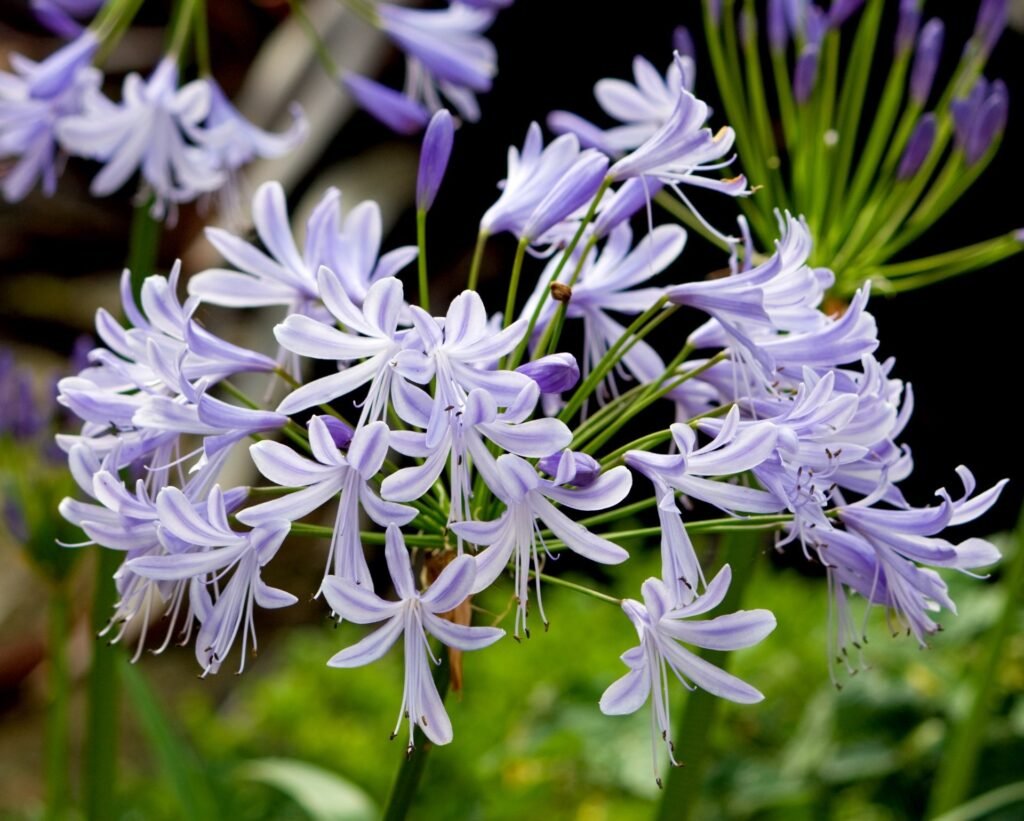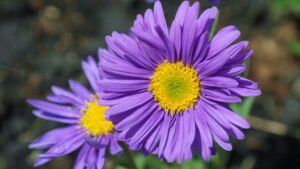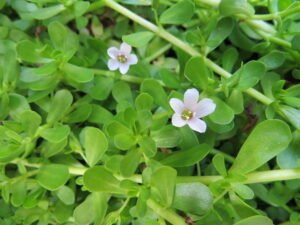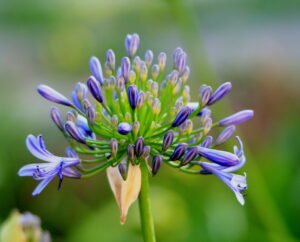Lily of the Nile: How to Grow and Care for Lily of the Nile

Lily of the Nile
The Lily of the Nile, scientifically known as Agapanthus, is a captivating perennial that has garnered admiration from gardeners worldwide. Originating from the temperate regions of South Africa, this plant is celebrated for its striking clusters of blue or white flowers that add a touch of elegance to any garden. The name “Lily of the Nile” is somewhat of a misnomer, as the plant does not actually hail from the Nile region but has been named for its exotic and enchanting appearance. This article explains in detail how to grow and care for Lily of the Nile plant.

In terms of aesthetics, the Lily of the Nile is unmatched. Its tall, slender stems support umbels of tubular flowers that bloom in shades of blue, violet, and occasionally white. These blooms not only provide a visually pleasing spectacle but also attract pollinators such as bees and butterflies, enhancing the ecological value of the garden. The plant’s lush, strap-like leaves remain evergreen in milder climates, providing year-round interest and structure.
Facts About Lily of the Nile
Plant History
The Lily of the Nile holds a rich tapestry of historical significance, particularly among ancient African civilizations. This revered plant was not merely an ornamental beauty but was deeply woven into the cultural, medicinal, and symbolic fabric of the societies that cherished it.
In many African cultures, the plant was associated with the divine feminine and was believed to enhance fertility and bring blessings to families. The strikingly beautiful blue and white blooms were seen as a representation of purity, often used in spiritual contexts to invoke protection and divine favor.
During the 17th and 18th centuries, the Lily of the Nile gained prominence in European botanical gardens. The plant was included in numerous botanical texts, with detailed illustrations and descriptions highlighting its distinguishing features. Scholars and botanists such as Carl Linnaeus, who is renowned for his work in taxonomy, contributed to the classification and understanding of the Agapanthus species. Linnaeus’s system of binomial nomenclature provided a framework that facilitated the accurate identification and naming of the Lily of the Nile.
The introduction of the Lily of the Nile to Europe ignited a wave of interest among horticulturists and garden enthusiasts. The plant’s ornamental value led to its widespread cultivation in gardens and estates across the continent. Its adaptability to various climates and soil conditions further enhanced its popularity, making it a sought-after addition to cultivated landscapes.
In addition to Europe, the Lily of the Nile was also introduced to other parts of the world, including the Americas and Asia. Botanical studies continued to evolve, with researchers exploring the plant’s medicinal properties, propagation methods, and ecological significance. The colonial era thus played a pivotal role in the global dissemination and appreciation of the Lily of the Nile, laying the foundation for its enduring legacy in botanical history.
The term ‘Agapanthus’ itself is derived from the Greek words ‘agape,’ meaning love, and ‘anthos,’ meaning flower, thus often earning the title ‘Flower of Love.’ This nomenclature underscores the plant’s ornamental value and its role in romantic or decorative settings.
Plant Fact
Common Names: African Lily, Blue African Lily, Nile Lily, Agapanthus, Flower of Love and Star of Bethlehem (Australia).
Sunlight: Lily of the Nile should receive full sun to partial shade. Full sun, defined as six or more hours of direct sunlight per day, is generally optimal for encouraging abundant flowering. However, in regions with extremely hot summers, partial shade—particularly during the hottest part of the day—can help prevent leaf scorch and stress.
Hardiness Zones: Lily of the Nile flourishes best in USDA hardiness zones 7 through 11. Zone 7, characterized by a minimum temperature range of 0°F to 10°F, allows Lily of the Nile to thrive with proper winter protection. Zones 8-11, with milder winters and warmer summers, provide an ideal environment for robust growth, with temperatures rarely dropping below 10°F.
Spread & Height: Most commonly, these plants reach a height ranging from 18 inches to 4 feet. The spread of the plant is equally impressive, with mature specimens spanning up to 2 to 3 feet in width.
Flowering Time: The flowering time of the Lily of the Nile typically extends from late spring to early autumn.
Toxicity: Various parts of the Lily of the Nile, particularly the sap and bulbs, contain toxic compounds that can pose risks to both humans and pets. The primary toxic substances found in this plant are saponins and oxalates. Exposure to these toxic compounds can occur through ingestion or skin contact. Ingesting parts of the plant can lead to symptoms such as nausea, vomiting, diarrhea, and abdominal pain. Direct skin contact with the sap may result in irritation, redness, or even blistering in more severe cases. It is essential to handle the plant with care, especially when pruning or propagating, to avoid any adverse effects.
Annual/Perennial: The Lily of the Nile is generally classified as a perennial plant. This means that under suitable frost free conditions, it can thrive and bloom annually for many years. Once established, these plants can be a robust addition to any garden, providing vibrant clusters of blue, white, or purple flowers year after year.
Varieties of Lily of the Nile
The Lily of the Nile comes in a diverse range of varieties, each bringing its unique charm to garden settings. These varieties broadly fall into two categories: dwarf forms and standard forms. The distinction between these forms is primarily based on their height and growth habit, which can significantly influence their suitability for different garden spaces.
The standard forms, such as ‘African Queen’, can reach impressive heights of up to 4 feet. This variety is renowned for its large, deep blue flowers that bloom profusely during the summer months. Its tall and robust stature makes it an excellent choice for creating dramatic focal points in gardens, especially in climates that offer mild winters and warm, sunny conditions.
In contrast, dwarf forms like ‘Peter Pan’ grow to a more modest height, usually around 1-2 feet. This variety is particularly favored for smaller garden spaces or container gardening. ‘Peter Pan’ produces abundant clusters of light blue flowers, adding a touch of elegance without overwhelming the surrounding plants. Its compact size also makes it ideal for edging borders or planting in rock gardens.
Color variations among Agapanthus varieties range from deep indigo to light lavender and even pure white. For instance, ‘Blue Storm’ is a popular cultivar that features striking blue flowers and is known for its vigorous growth and resilience in various climates. Its ability to withstand harsher conditions makes it a versatile choice for gardeners in regions with variable weather.
Beyond flower color and size, Lily of the Nile varieties also differ in their foliage types. Some have broad, strap-like leaves that add a lush, tropical appearance to the garden, while others have more narrow, grass-like foliage that offers a delicate, airy texture. These differences in leaf structure can enhance the visual appeal and compatibility of the Agapanthus with other garden plants.
Ultimately, selecting the right variety of Lily of the Nile depends on your garden’s specific needs and the climate in which you live. By understanding the distinct characteristics and requirements of each variety, you can ensure that these beautiful plants thrive and add enduring beauty to your outdoor spaces.
How To Propagate Lily of the Nile Plant
Propagating the Lily of the Nile can be achieved through two primary methods: division of clumps and growing from seeds. Each method has its own set of advantages and considerations, catering to different gardening goals and experiences.
When considering the optimal period to propagate Lily of the Nile, commonly known as Agapanthus, one must focus on the late spring to early summer timeframe. This season, spanning from late May to early July in most temperate climates, provides ideal conditions conducive to successful propagation.
The late spring to early summer period coincides with the peak active growth phase of Agapanthus. During this time, the plant exhibits robust vegetative growth, which enhances its ability to recover from the division process inherent to propagation. The increased metabolic activity ensures that the plant can develop new roots and foliage more efficiently, leading to higher chances of successful establishment.
Division
Division is the most common and reliable method for propagating Lily of the Nile. This process involves separating a mature plant into smaller sections, each with a healthy root system. To begin, gently dig up the mature Lily of the Nile plant, being careful not to damage the roots. Shake off excess soil and use a sharp, sterilized knife to cut the clump into smaller sections, ensuring each section has at least one growing point and a robust root system.
Once divided, replant the sections in well-prepared soil, positioning them at the same depth they were previously growing. Water thoroughly to help the roots establish. One major advantage of division is that it produces mature, blooming plants more quickly compared to other methods. However, it can be labor-intensive and may cause temporary stress to the plant.
Seeds
Growing Lily of the Nile from seeds is another viable method, though it requires more patience. Start by collecting seeds from mature plants in late summer or early autumn. Plant the seeds in a tray that has been filled with a seed-starting mix that drains well. Lightly cover the seeds with soil and water gently to keep the medium consistently moist.
Keep the tray out of direct sunlight and place it somewhere warm. Germination can take several weeks to months, so patience is key. Once the seedlings are large enough to handle, transplant them into individual pots. Growing from seeds allows for the production of numerous plants, but these may take several years to reach blooming maturity.
Both propagation methods have their unique benefits and care requirements. Division offers quicker results and mature plants, while seed propagation provides an economical way to produce many plants but requires a longer timeframe. Regardless of the method chosen, proper care and attention to the newly propagated Lily of the Nile plants will ensure their healthy growth and vibrant blooms.
How To Plant Lily of the Nile
The best time to plant Lily of the Nile is in the spring or early summer, once the danger of frost has passed. This timing allows the plants to establish roots before the heat of summer. For gardeners in colder climates, planting in containers enables easier relocation to a frost-free area during winter months.
Planting Lily of the Nile, also known as Agapanthus, requires careful consideration of location, soil preparation, spacing, and planting depth to ensure optimal growth. Selecting the right location is paramount; these plants thrive in full sun to partial shade, making them ideal for a spot that receives at least six hours of sunlight daily. For regions with extremely hot climates, some afternoon shade can help protect the plants from scorching.
The soil need to have good drainage and a high content of organic matter. Start by loosening the soil to a depth of about 12 inches and incorporating compost or well-rotted manure to enhance fertility and drainage. If planting in garden beds, space the plants 18 to 24 inches apart to allow sufficient room for growth and airflow, thereby reducing the risk of disease. In containers, ensure the pot has adequate drainage holes to prevent waterlogging, which can lead to root rot.
When it comes to planting depth, the crown of the Lily of the Nile should be positioned just above the soil surface. This positioning is crucial for preventing rot and ensuring that the plant establishes well. Gently firm the soil around the roots and water thoroughly to settle the soil and eliminate air pockets. Mulching around the plants with organic mulch can help retain moisture and suppress weeds.
Proper planting techniques set the stage for healthy growth and vibrant blooms, making Lily of the Nile a stunning addition to any garden or container display.
How To Care For Lily of the Nile
Sunlight
The Lily of the Nile requires specific sunlight conditions to thrive and reach its full blooming potential. Understanding these requirements is crucial for ensuring the health and vibrancy of these striking plants. Generally, Agapanthus prefers full sun to partial shade, and this preference can vary significantly based on the regional climate.
In cooler climates, full sun exposure is highly beneficial for the Lily of the Nile. The abundant sunlight helps the plant maximize its blooming potential, resulting in more prolific and vibrant flowers. Typically, a daily duration of around six hours of direct sunlight is ideal. This sunlight exposure ensures that the plant receives enough energy for robust growth and blooming.
However, in hotter regions, prolonged exposure to intense sunlight can be detrimental. In such climates, partial shade becomes essential to prevent leaf scorch and reduce stress on the plant. Partial shade during the hottest parts of the day helps in maintaining the plant’s health and prevents the leaves from turning brown or discolored due to excessive sunlight.
Soil
When it comes to soil, the Lily of the Nile prefers well-draining, fertile soil. It is essential to ensure the soil is neither too compact nor waterlogged, as this can hinder the plant’s growth and health. A soil mix rich in organic matter will support the plant’s nutritional needs and enhance its overall vigor. Additionally, the ideal soil pH for Lily of the Nile ranges from slightly acidic to neutral, typically between 6.0 and 7.0.
Watering
The Lily of the Nile, or Agapanthus, is a resilient plant that thrives when its watering needs are met with precision. It is crucial to maintain a balance between keeping the soil consistently moist and avoiding waterlogged conditions, which can lead to root rot. During the growing season, typically spring through summer, the soil should be kept moist but not saturated. A general rule of thumb is to water the plant thoroughly, allowing the top inch of soil to dry out before watering again. This approach ensures that the roots receive adequate moisture without being drowned.
In contrast, during the dormant period in fall and winter, the watering frequency should be reduced significantly. Overwatering during this phase can be detrimental, as the plant’s water requirements diminish. Monitoring the soil moisture levels and adjusting the watering schedule accordingly is essential for the Lily of the Nile’s health.
Fertilizing
Fertilizing plays a pivotal role in promoting the robust growth and vibrant blooms of the Lily of the Nile. A balanced, slow-release fertilizer, typically with an N-P-K ratio of 10-10-10, is recommended. During the active growing months, applying this fertilizer every 6-8 weeks can provide the necessary nutrients for optimal growth. Organic options, such as compost or well-rotted manure, can also be beneficial.
Particularly beneficial nutrients for the Lily of the Nile include phosphorus and potassium, which support blooming and overall plant vigor. Phosphorus encourages strong root development and enhances flower production, while potassium helps in maintaining the plant’s overall health and resistance to diseases. When applying fertilizer, it is important to follow the manufacturer’s instructions to avoid over-fertilization, which can lead to nutrient burn and negatively impact the plant.
Pruning
Effective pruning is essential for maintaining the health and aesthetic appeal of the Lily of the Nile. Pruning should be undertaken with a methodical approach to ensure the plant thrives and remains visually appealing throughout its lifecycle. The optimal time for pruning is in the early spring, just before the new growth begins, and again after the flowering period has ended.
Deadheading spent flowers is a crucial practice in the pruning process. Once the blooms of the Lily of the Nile have faded, they should be carefully removed to not only improve the plant’s appearance but also to encourage further blooming. Deadheading involves cutting the flower stalks down to the base of the plant. This prevents the plant from wasting energy on seed production, redirecting its resources toward new growth and flowering.
Removing dead or damaged foliage is another key aspect of pruning. This process helps to prevent disease and pest infestations and allows the plant to focus its energy on healthy, vibrant leaves and flowers. Damaged leaves should be cut back to their base, ensuring that the cut is clean to avoid any potential entry points for pathogens.
Common Problems and Solutions
Growing Lily of the Nile (Agapanthus) can be a rewarding experience, but it is not without its challenges. Gardeners often encounter a variety of issues that can affect the health and appearance of this elegant plant. By understanding these common problems and their solutions, you can ensure that your Lily of the Nile thrives.
Pests
Aphids and snails are frequent pests that can harm Lily of the Nile. Aphids typically cluster on new growth and flower buds, sucking the plant’s sap and potentially transmitting diseases. To combat aphids, consider using insecticidal soap or neem oil. For organic control, introducing beneficial insects like ladybugs can be effective. Snails, on the other hand, can cause significant damage to leaves and stems. Hand-picking snails during the evening or using organic snail bait can help keep their population in check.
Diseases
Root rot and leaf spot are common diseases affecting Lily of the Nile. Root rot is often caused by overwatering or poorly draining soil, leading to mushy, discolored roots. To prevent root rot, ensure the plant is in well-draining soil and avoid excessive watering. If root rot is detected, removing affected roots and replanting in fresh soil can save the plant. Leaf spot, characterized by brown or black spots on leaves, is usually a result of fungal infection. Regularly removing affected leaves and applying a fungicide can help control the spread of leaf spot.
Environmental Stress
Lily of the Nile is susceptible to environmental stress, including frost damage and drought. Frost can cause leaves to become discolored and wilted. To protect the plant, cover it with frost cloth or move potted plants indoors during cold snaps. In contrast, drought stress manifests as yellowing leaves and stunted growth. Ensuring consistent watering, especially during dry periods, is crucial for maintaining plant health.
By addressing these common problems with practical solutions, you can maintain the health and beauty of your Lily of the Nile, ensuring it remains a stunning addition to your garden.





